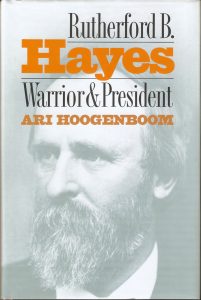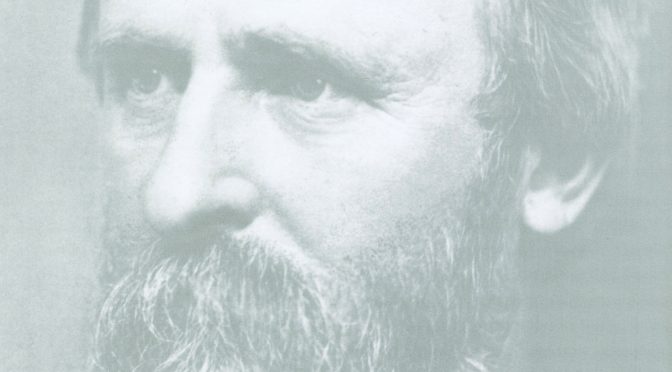It was a disputed election in 1876. While it appeared that the Democratic candidate, Samuel J. Tilden of New York, had won the popular vote, neither he nor the Republican, Rutherford B. Hayes of Ohio, had enough electoral votes to claim victory. It turned into a long and nasty fight. The dispute focused on the election returns from three Southern states: Florida, Louisiana and South Carolina, where there had been widespread racial voter intimidation and fraud.
 To resolve the crisis, President Grant helped form a 15-person committee made up of both Democrats and Republicans to decide which candidate would receive the electoral votes from each of the disputed states. The committee consisted of five members from the House, five from the Senate and five from the Supreme Court. The wrangling lasted until early March, just two days before inauguration. The transition was held in early March back then. To secure his path to the presidency, author Ari Hoogenboom writes in “Rutherford B. Hayes: Warrior & President,” Hayes himself did not make any concessions, but those working for him did make offers.
To resolve the crisis, President Grant helped form a 15-person committee made up of both Democrats and Republicans to decide which candidate would receive the electoral votes from each of the disputed states. The committee consisted of five members from the House, five from the Senate and five from the Supreme Court. The wrangling lasted until early March, just two days before inauguration. The transition was held in early March back then. To secure his path to the presidency, author Ari Hoogenboom writes in “Rutherford B. Hayes: Warrior & President,” Hayes himself did not make any concessions, but those working for him did make offers.
Shortly after Hayes became president, he withdrew federal troops that had been stationed in South Carolina and Louisiana to protect voting rights, and the governments in those states immediately flipped from Republican to Democratic control. This effectively ended the Reconstruction era following the Civil War.
As Hoogenboom writes, Hayes really had no choice. By this point there was no longer an appetite in the North for continued troop presence in the South. Besides, Hayes believed that over time, with more education and economic opportunities for all, racism would fade and American society would become more egalitarian. How very wrong he was about that. In actuality, getting the federal government out of the way and allowing the South to establish “home rule” led to almost a century more of racial violence and voter suppression.
During his presidency, Hayes pushed for civil service reform. This was his No. 1 issue. He wanted to upend the established practice of patronage appointments for government jobs. Up until this point, Senators and Congressmen were allowed to dispense appointments to their friends and allies under the “spoils system.” In return, those who received such employment had to give a portion of their pay to the political bosses who had gotten them their jobs. It was all very corrupt.
Hayes wanted to change all that. He wanted civil servants to be hired on the basis of competitive written examinations, and he did not want them to be fired for not making payments to politicians. This turned into an epic battle between Hayes and his party, with Congress, and especially with a powerful “Stalwart” Republican Senator from New York, Roscoe Conkling (not Roscoe P. Conkling, who was someone else). Senator Conkling controlled the lucrative New York Custom House, which was run by his lackey, Chester A. Arthur. Hayes ultimately had Arthur fired, setting up an epic battle with Conkling that would one day have immense consequences for the country that nobody could have imagined at the time.
President Hayes also dealt with violent railroad strikes and disputes over the nation’s money supply and the gold standard. He dealt with Indian affairs and with anti-Chinese immigration fervor. He won showdowns with Congress over “riders” aimed at voter suppression that were added by Southern Democrats to spending bills. Later in his presidency, a commission was formed go back and investigate the 1876 election, but that ultimately led nowhere.
Before Hayes became president, he served in the Civil War. He was an officer, and he fought bravely and was instrumental in some key battles. He was also injured numerous times. He was elected to Congress while he was still serving with the Union army in Virginia, but he did not leave the battlefield to campaign. All he did was write home in a letter: “An officer fit for duty who at this crisis would abandon his post to electioneer for a seat in Congress ought to be scalped,” and when these words were made pubic in the newspapers, he was elected resoundingly. After the war Hayes also served as governor of Ohio. He got his start in politics before the war, when he was elected City Solicitor in Cincinnati.
Here are some additional facts about our nation’s 19th president:
- From the beginning, Hayes had pledged not to run for a second term. He long advocated for a constitutional amendment giving the chief executive a single six-year term.
- Hayes traveled extensively while in office. He was the first President to visit the West Coast.
- He had a full beard.
- The B was for Birchard, his mother’s maiden name.
- He was married to Lucy, and they had many children, mostly sons. Some of the children died while very young.
- He banned alcoholic beverages from the White House. He did so in part to mollify teetotalers who wanted to form a new political party that would have harmed the Republicans.
- Despite not serving booze, the Hayses were fun people who knew how to entertain. They threw lots of parties. And when they went to parties, they were often the first guests to arrive.
- His father died when he was very young. He was raised by his mother and his uncle, Sardis Birchard. Uncle Sardis acted as a surrogate father to Hayes, and later to his sons. He built them a house.
- Uncle Sardis was racist.
- Hayes was not racist and was anti-slavery. He supported John C. Fremont, the anti-slavery candidate, in the 1856 presidential election. And, like his immediate successor, James A. Garfield, who was also from Ohio and also fought for the Union, he viewed the Civil War as a battle to end slavery in our country once and for all.
- Hayes believed strongly in the 13th, 14th and 15th amendments (the “Reconstruction Amendments”), and felt that these amendments should be enforced in the South.
- Before and after the Civil War, Hayes had many Southerners as friends. He met them in college. He never understood how they could be opposed to racial equality.
- Although Hayes attended church regularly, he never joined a denomination and never “drank the Kool-Aid.” In other words, he did not fall for crazy ramblings of any preachers.
After his presidency, Hayes stayed active in public life and championed a number of what we would call today “progressive” causes. Education, especially education for blacks, prison reform, and Native American issues were causes he championed. He was involved on committees and foundations, and he traveled extensively. One of the beneficiaries of an educational scholarship he awarded through a fund he stewarded was W.E.B. DuBois, who would go on to become an influential author and civil rights activist. Hayes also continued to advocate for civil service reform and stayed abreast of politics. He also was active in Civil War veterans associations. He died in 1893 at age 70.
As presidential biographies go, I found “Rutherford B. Hayes: Warrior & President” to be well researched and thorough. For some reason though, this was not the most fun book I have ever read. It seemed to take me a long, long time to get through it, and I am not sure why. Despite not enjoying the book much, I did come to like Hayes as a person, especially after he left the presidency and continued to fight for what he believed in.
The reputation of Hayes suffered over time, with many historians considering him a mediocre president. But Hoogenboom argues that this reputation was not warranted. It was not Hayes himself who compromised with the racists in the South over “home rule,” but rather those who had been working on his behalf. Nevertheless, it was the decision of Hayes to pull federal troops from South Carolina and Louisiana, effectively ending Reconstruction and leaving the blacks at the mercy of white supremacists and their racial violence, harassment and voter intimidation.
For me, reading about his post-presidency advocacy was most inspiring. Hayes could have simply led a life of leisure after leaving office. He certainly had enough money. Yet, like former President Jimmy Carter does today, Hayes continued to serve. That, for me, counts for so much.

